Auto Accident
California Implements Daytime Headlight Law On Highway 99 Stretch
| September 30th, 2020
Running daytime headlights is a safety technique that has been utilized by motorcycles for years to make themselves more visible to other vehicles. Studies have shown that the use of headlights during the day can reduce the chances of a vehicle being in an accident by as much as 23%. In California, drivers are legally required on certain stretches of highway to run headlights during the day to reduce the number of crashes.Daylight Headlight Section on Highway 99
All vehicles on the 29-mile length of Highway 99, between Chico and Red Bluff, California, are required to have their headlights on at all times. When the mandate was first given, officials said the area was notoriously plagued by a high number of motor vehicle accidents along the narrow, winding road. Officials worked for more than 18-months to have the initiative passed. Caltrans workers then began installing daytime headlight warning signs along the highway to remind drivers of the new measure.Did the Daylight Headlight Section Actually Work?
Yes. In the seven years following the implementation of the daylight headlight section, the results were impressive. On the Tehama portion of this daylight headlight section, there were:- 2% fewer daytime crashes resulting in property damage.
- 8% fewer crashes involving injuries.
- No fatal crashes on this stretch from 2014-2017.
Benefits of Daytime Headlights
Studies show varied results of leaving headlights on during the day, but many suggest that they do reduce the risks of being involved in crashes. That’s true for both standard headlights turned on during the day and daytime running lights, which are designed solely to be kept on during daylight. Keeping headlights on during the day is also beneficial when visibility is low due to inclement weather.California’s Headlight Laws
California’s headlight laws state that drivers in California are required to use headlights:- In the dark.
- When continuous use of windshield wipers is needed.
- When visibility is less than 1,000 feet.
We’re Advocates of Daylight Headlight Usage
The number of California car accidents could be significantly reduced if all drivers adopted the use of daytime running headlights. That’s why the San Francisco personal injury lawyers with Berg Injury Lawyers ask that all drivers always turn on their headlights, regardless of the time of day, before driving anywhere. If you’d like to learn more about California’s road and vehicle laws, here are some more resources you might enjoy: This story was originally published in May 2012. It was updated in October 2020.When Should You Report a Car Accident in California?
| September 14th, 2020
 After a crash, the last thing most people want to do is call the police and wait until they arrive on the scene to file a report. But it’s important to know when you’re required to report a car accident in California.
In certain circumstances, a failure to do so won’t just make it harder to establish fault if you decide to file a compensation claim; it could even result in criminal charges.
So, when is it necessary to report a crash? Here’s what you need to know.
After a crash, the last thing most people want to do is call the police and wait until they arrive on the scene to file a report. But it’s important to know when you’re required to report a car accident in California.
In certain circumstances, a failure to do so won’t just make it harder to establish fault if you decide to file a compensation claim; it could even result in criminal charges.
So, when is it necessary to report a crash? Here’s what you need to know.
It’s a Requirement to Report a Vehicle Crash in California If…
- Property damage exceeds $1000.
- Someone was injured in the crash.
- Someone was killed in the crash.
Making the Case for Always Reporting a Crash
Now that we know California’s laws about reporting a car accident, let’s go a step further. From the perspective a vehicle accident attorney, it’s best practice to always report a crash. First, though it’s possible to file an insurance claim without a police report, proving that you weren’t at fault for the crash is far more difficult without that report. Fault matters when it comes to insurance claims, and you’ll want to be sure to have a police report that reflects the other driver’s role in causing the accident. Second, it’s incredibly difficult for someone involved in a crash to know the monetary value of damage their vehicle has sustained. A small “ding” could be just the beginning of the damage to the vehicle. Assume that any damage will be more costly to repair than it initially appears. Third, just like it’s hard to know how much damage a vehicle has sustained, it’s equally if not more difficult to know how injured a person is after an accident. Crash-related injuries are often far worse than they initially appear; the injured person usually has enough adrenaline pumping through their body from the shock of the crash to mask symptoms. If there’s the slightest indication that you’ve been hurt, report the accident and seek medical treatment as soon as possible.What Happens If You Don’t Report a Crash in California?
By failing to report a car accident that involves significant property damage, you could have your license suspended by the DMV. If you were involved in a crash where someone else was seriously injured and you leave the scene before police arrive, you could face criminal charges, including imprisonment of up to 3 years, and up $10,000 in fines for a felony hit-and-run.Don’t Take the Chance—Report the Crash
When you don’t report an accident in California, you accept unnecessary risks. What if someone is more injured than they appear at the scene of the crash? What if the amount of property damage is far greater than it seems right after the accident? There are too many factors at play to know when it’s okay not to report the crash. So, we suggest playing it safe and calling the authorities as soon as the accident happens.If You Need Help, Contact Berg Injury Lawyers
The California car accident attorneys at Berg Injury Lawyers have years of experience handling vehicle crash claims involving serious injuries. If you need help, contact us today to schedule a free consultation.What Is the Safest Time of Day to Ride a Bicycle in California?
| August 17th, 2020
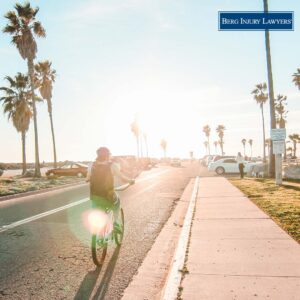 California is one of the three most dangerous states in the U.S. for cyclists, and the problem is only getting worse. Between 2016 to 2018, more cyclists died in California traffic accidents than in any three-year period since the mid-1990s.
Because of the significant danger, cyclists in California should also use caution when riding on busy roads, and knowing the safest times to ride could help keep more cyclists safe.
California is one of the three most dangerous states in the U.S. for cyclists, and the problem is only getting worse. Between 2016 to 2018, more cyclists died in California traffic accidents than in any three-year period since the mid-1990s.
Because of the significant danger, cyclists in California should also use caution when riding on busy roads, and knowing the safest times to ride could help keep more cyclists safe.
When Are California Cyclists Most at Risk for a Crash?
Based on statistics from 2017, the latest year for which finalized data is available, 21% of all bicyclist crash deaths happen between 6 p.m. and 9 p.m. During this time of day, visibility is lower, and traffic is still relatively high, making it particularly dangerous for cyclists. The next most dangerous times of day is 9 p.m. to midnight (18% of all bicycle crash deaths) followed by 3 p.m. to 6 p.m. (15% of all crash deaths). Other factors also increase the chances of bicycle accidents. For example, 75% of all bicycle crash fatalities occur in urban areas. Alcohol use contributes to more than one-third of all bicycle crash deaths, and intoxication by drivers and cyclists can both contribute to the problem.When Are California Cyclists Safest on Our Roads?
Now that we know the most dangerous times of the day, we can determine that cyclists are safest when visibility is high, but less traffic is on the road. So, ideally, cyclists should travel in daylight during non-rush-hour traffic. Unfortunately, riding only during the safest times of the day is simply not possible for many cyclists in California. To avoid increasing their risks of being involved in a crash, cyclists can take several other precautions.How Cyclists Can Stay Safe on California’s Roads
If cyclists can’t avoid riding during times of heavy traffic when driver visibility is low, they can make sure they’re equipped with the proper safety gear. The more visible they are to drivers, the easier it will be for those motorists to see them. Cyclists can wear brightly colored or reflective clothing when riding in the dark. They should have a headlight, a red light, or a reflector on the rear of their bikes, and a white or yellow reflector on each pedal. To learn more about California’s legal requirements regarding safety equipment, check out our guide to California’s bicycle laws.The Responsibilities of Drivers Toward Cyclists
If we want to make California safer for cyclists, drivers must make sure they’re following the law and safely sharing roads. This means:- Never driving in designated bike lanes.
- Yielding to cyclists the same way you would for any other motorist.
- Looking out for cyclists when turning at intersections or right on red lights.
- Giving cyclists plenty of room on our roads.
If You Need Legal Help, Contact Berg Injury Lawyers
Our Northern California bicycle accident attorneys have helped many injured cyclists get the compensation they’re entitled to. These cases typically involve crashes with severe injuries, and it’s important for injured cyclists to know that they might deserve more payment than the insurance company first offers them. If you’d like to speak to our legal team about your case, contact us today for a free consultation.Buying a Safe Bicycle Helmet
| August 10th, 2020
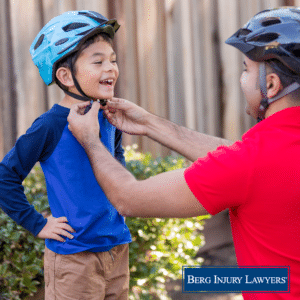 Here’s a sobering concept: the bicycle helmet you’ve been wearing might not meet federal safety standards. You might assume, as many people do, that all bicycle helmets sold in the U.S. are required to meet the Consumer Product Safety Commission’s (CPSC) standards, but the reality isn’t as clear-cut.
Technically, helmets are required to meet those standards, but in the online retail world, many bicycle helmets, some of which are widely sold and purchased, do not meet those standards. Consumer Reports researchers alone identified 13 helmets that didn’t include a CPSC compliance label. And many of those non-compliant helmets were offered on some of the biggest online shopping platforms.
In short, be extra careful when you buy a bicycle helmet. But what exactly should you be looking for? Let’s find out.
Here’s a sobering concept: the bicycle helmet you’ve been wearing might not meet federal safety standards. You might assume, as many people do, that all bicycle helmets sold in the U.S. are required to meet the Consumer Product Safety Commission’s (CPSC) standards, but the reality isn’t as clear-cut.
Technically, helmets are required to meet those standards, but in the online retail world, many bicycle helmets, some of which are widely sold and purchased, do not meet those standards. Consumer Reports researchers alone identified 13 helmets that didn’t include a CPSC compliance label. And many of those non-compliant helmets were offered on some of the biggest online shopping platforms.
In short, be extra careful when you buy a bicycle helmet. But what exactly should you be looking for? Let’s find out.
How Do You Know Which Helmets Are Safe?
First things first, look for a helmet with a label stating that it complies with the CPSC’s standard. It’s possible that labels on some of these helmets are counterfeit, but it’s a good place to start. Next, Consumer Reports says that you should look for “the name, address, and telephone number of the manufacturer or importer issuing the certificate.” In some cases, the information will be that of the private labeler of the helmet. Next, look for a serial number or other information that identifies the production lot of the product. This will also allow you to find out the month and year the helmet was manufactured. All this information can help you verify that the helmet you purchased does in fact comply with federal safety standards. Though online shopping tempts helmet buyers through easy shipping and budget prices, the safest approach is to visit a local shop that sells reputable products. Choosing a helmet in person not only makes it easier to inspect it for quality, but it also gives you a chance to try it on. Helmet fit is vital when it comes to safety. Helmets that are too small or too big don’t protect as well as helmets that fit properly. Curious about California’s bicycle safety laws? We’ve compiled a list of everything you need to know in another blog post.Picking the Right Helmet for You
Now that you know how to avoid buying an unsafe helmet, it’s important to look for a helmet that fits your specific needs. This means finding a helmet with the proper fit that’s made for your style of biking (road, mountain, or recreational, for example). Take some time to research the level of protection each option you’re considering offers. Look at the weight, shielding, and straps to determine whether a helmet will be comfortable.Caring for Your Helmet
Once you have a helmet you like, make sure you follow best practices to get the most out of it. That means cleaning it frequently and making sure the straps and buckles fit securely each time you ride. If your helmet is ever struck or damaged, even just a bit, stop using it and buy a new one. One small impact can greatly reduce a helmet’s effectiveness, so don’t take any chances. Don’t donate it or give it away, as it could put another cyclist at risk during a crash.At Berg Injury Lawyers, We Have Bicyclists’ Backs
Our California bicycle accident attorneys have represented many cyclists in personal injury claims, and we always work hard to get them fair treatment and compensation. Whether an injury is caused by a defective product or a negligent driver, bicyclists should know that they almost always have legal options available, as long as they act fast, before the statute of limitations closes. If you or a loved one was injured in a bicycle accident, contact our team to schedule a free consultation.California’s Bicycle Laws Explained
| August 3rd, 2020
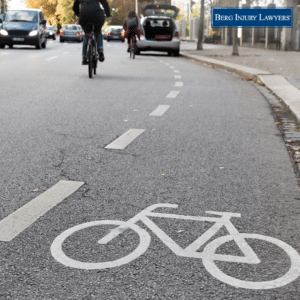 Understanding California’s bicycle laws is essential for every cyclist in our state. From helmet laws to bicycle lane laws, California is very specific about what’s expected of cyclists.
To begin our comprehensive list of California’s bicycle laws, let’s start with the required equipment.
Understanding California’s bicycle laws is essential for every cyclist in our state. From helmet laws to bicycle lane laws, California is very specific about what’s expected of cyclists.
To begin our comprehensive list of California’s bicycle laws, let’s start with the required equipment.
Bicycle Helmet Laws in California
California law is clear about the helmet requirements for riders under the age of 18. Parents are responsible for ensuring that minors have proper equipment when they ride.Cyclists Under the Age of 18
No cyclist under the age of 18 should ride a bike without a helmet. That helmet must be properly fitted and fastened. The helmet must meet the standards of either the American Society for Testing and Materials (ASTM) or the United States Consumer Product Safety Commission (CPSC). This also applies to any bicycle passenger in a restraining seat attached to the bicycle or in a trailer towed by the bicycle. Helmets must be clearly labeled by the manufacturer to display compliance with the safety standards of the ASTM or the CPSC.Cyclists Age 18 and Older
There are no state requirements for cyclists age 18 and older. But, you should always wear a helmet when riding a bicycle for safety purposes. Wearing a bicycle helmet reduces your risk of suffering a head injury by more than 50%. When buying a helmet, make sure it is in keeping with CPSC standards.More Laws Regarding Bicycle Equipment and Size
In addition to helmet requirements, cyclists in California must ensure their bikes also meet certain requirements:- Cyclists can’t operate a bike on a roadway unless the bicycle has a brake that will enable the cyclist “to make one braked wheel skid on dry, level, clean pavement,” which is the legal standard for an effective bicycle brake.
- A bike’s handlebars should never be positioned so that the cyclist must elevate their hands above shoulder level to steer.
- A cyclist shouldn’t ride a bike so big that its size prevents them from “safely stopping the bicycle, supporting it in an upright position with at least one foot on the ground, and restarting it in a safe manner.”
- A light that illuminates the road in front of the cyclist and is visible from 300 feet in front and from the sides of the bicycle. This light can be attached to the bike or the bicyclist.
- Either a red reflector, solid red lights, or flashing red lights visible from 500 feet to the rear of the bike.
- A white or yellow reflector on each pedal, shoe, or ankle visible from 200 feet to the front or rear of the bicycle.
- A white or yellow reflector on each side forward of the center of the bicycle, and a white or red reflector on each side to the rear of the center of the bicycle. Bicycles that are equipped with reflective front and rear tires are exempt.
- All reflectors or reflective tires should meet state requirements.
Rights and Responsibilities of Cyclists in California
California law states that bicyclists have the same rights and responsibilities as motorists. This means that the same rules (adhering to traffic signs and signals, watching out for pedestrians, signaling when turning) apply to bicyclists as they do for car drivers. It’s illegal for cyclists to ride a bike while they’re under the influence of drugs or alcohol. Bicyclists traveling at speeds slower than the normal flow of traffic must ride as close as possible to the right-hand curb or edge of the roadway UNLESS:- They are passing another bike or vehicle.
- They are turning left.
- Conditions of the road make traveling on the right-hand side dangerous.
- They are approaching a place where a right turn is authorized.
- They are traveling on a one-way street with two lanes, in which case riding as close to the left-hand side of the road as possible is allowed.
- It is unsafe to do so,
- You’re turning, or
- You need to pass another cyclist.
Don’t Attach Your Bike to Other Vehicles to Hitch a Ride
Bicyclists, along with every other vehicle type, are forbidden from attaching their bike to another vehicle for travel purposes. In other words, you can’t hitch a ride with other vehicles. This obviously doesn’t apply to cyclists who are simply loading their bikes on vehicles for hauling purposes.Ride Only on the Designated Seat
California law states that cyclists must ride on the designated seats of their bikes. This also applies to passengers. Unless a bike is equipped to seat two people, it should only be ridden by one person. In other words, no sitting on handlebars or standing on pegs.Don’t Haul Items That Restrict Your Ability to Safely Operate the Bike
When carrying items attached to a bicycle, cyclists must be able to keep at least one hand on the handlebars. So, no hauling items that restrict your ability to control the bike.California Laws Concerning Parking or Storing Your Bicycle
Cyclists shouldn’t leave their bikes lying on their side on sidewalks. They shouldn’t park bicycles on sidewalks in any position that obstructs the path of pedestrian traffic. Local authorities can prohibit bicycle parking in designated areas of the public highway, but it must place signs in these areas that clearly indicate these restrictions.What About Motorized Bicycles?
Motorized bicyclists also have many of the same rights and responsibilities of people riding or using other vehicles, though these vehicles are considered closer to motorcycles than bikes. For example, a motorized bicyclist can’t travel on a bicycle path or trail, bikeway, bicycle lane, equestrian trail, or hiking or recreational trail, unless it is within or adjacent to a roadway. Local ordinances might allow exceptions, but it’s best to reference those laws to make sure you’re following them.Don’t Loiter or Obstruct Bike Lanes
California law requires other road users (drivers, pedestrians, etc.) to keep bicycle lanes unobstructed. This means that people shouldn’t loiter, obstruct, or drive motorized vehicles in designated bicycle lanes.Cities Can Mandate Their Own Bicycle Laws, Too
These are just California’s bicycle laws, but each city has the right to impose stricter laws regarding bicycle use on roadways. Reference your city’s specific laws to see if any additional laws apply to bicyclists.Vehicle Drivers Have Responsibilities Toward Cyclists
Whether it’s staying out of bike lanes or giving cyclists plenty of space on our roads, motorists have an obligation to keep bicyclists safe. When they fail to follow the law, they can be held responsible for the harm they cause others. If you’re injured by a negligent driver in California, the law gives you the opportunity to hold that driver responsible for the injury-related costs you face. Through a personal injury claim, you can get compensation for medical bills, lost income, property damage, and pain and suffering.If You Need Legal Help, Contact Berg Injury Lawyers
At Berg Injury Lawyers, our California bicycle accident attorneys help injured cyclists get the compensation they’re entitled to by law. If you or a loved one has been injured by a negligent driver, contact our team to schedule a free consultation.How Many People Die Every Day From Texting and Driving?
| July 27th, 2020
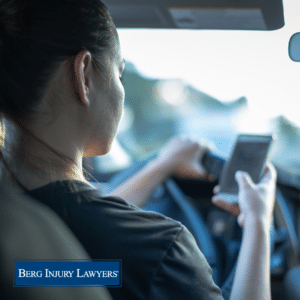 Every driver has heard about the dangers of texting and driving. The statistics speak volumes about the risks we introduce when we look at our mobile devices behind the wheel. Maybe you’ve heard a few of the following:
Every driver has heard about the dangers of texting and driving. The statistics speak volumes about the risks we introduce when we look at our mobile devices behind the wheel. Maybe you’ve heard a few of the following:
- Typing or reading a text message takes your eyes off the road for at least 5 seconds. For a driver traveling at 55 mph, that’s the equivalent of traveling the length of a football field with your eyes closed.
- For every 100 drivers, 20 are distracted 5 to 10% of the time and 10 drivers are distracted 15 to 20% of the time.
- According to a survey from DriversEd.com, 41% of drivers admitted to reading texts while stuck in traffic, and 11% admitted to texting while moving in traffic.
Knowing the Actual Number of Texting and Driving Deaths Is Difficult
Before we dive into some more numbers, let’s preface what follows by stating that there’s no way of knowing exactly how many deaths or injuries are caused by texting while driving, for reasons we’ll discuss below. Safety advocates always say that statistics of distraction-related crashes likely underestimate the actual numbers. So, as you read the statistics, remember that the problem is probably far greater than indicated.How Many People in the U.S. Die Every Day in Distracted Driving Accidents?
The Centers for Disease Control and Prevention says that each day in the U.S., approximately 9 people are killed and more than 1,000 injured in crashes involving a distracted driver. The Insurance Information Institute estimates that 9% of all fatal crashes in the U.S. are caused by distraction (based on figures from 2017).Why the Numbers Are Probably Much Higher
Safety advocates like those at the National Highway Traffic Safety Administration and the National Safety Council (NSC) talk at length about the limitations of crash reports. Data relies primarily on police reports, which presents several challenges. First, if a distracted driver causes a crash, a reporting police officer might not know the driver was texting or distracted in some other way unless the driver, victim, or witness mentions it to the officer. Second, not all crash reports that police are required to fill out have available fields for distraction, so even if an officer knows that distraction was the cause, they might label the cause of the crash as “other.” A review by the NSC indicates that 26 states in the U.S. lack crash report fields to capture texting, while 32 states lack fields to capture hands-free phone use.What Does It All Mean for Crash Victims?
The fact that calculating the actual number of distraction-related crashes is so hard shouldn’t deter victims of bad drivers from filing claims after an accident. In some cases, an attorney representing the injured person can prove the driver was distracted. Even if an attorney can’t prove that the at-fault driver was distracted, they can still prove the driver was negligent. For example, if a driver who is texting while driving strikes a pedestrian, it won’t matter why the at-fault driver struck the pedestrian; it will only matter that they failed to adhere to driving laws.If You Need Legal Help, Contact Berg Injury Laws
We’ve been helping clients in Northern California since 1981. We know what it takes to get an injured person the compensation they’re entitled to. If you or a loved one was injured by a distracted or negligent driver, we can help. Contact our California car accident attorneys today for a free consultation.Tips for Driving in California’s Extreme Heat
| July 6th, 2020
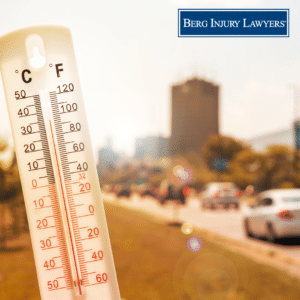 In California, we’re fortunate to have some of the most accommodating, beautiful weather in the U.S. But we’re also no strangers to extreme heat. Northern California has already experienced one heat wave this year, and the chances are good that more will come.
As we head into the hottest days of summer, it’s a good time to re-evaluate your plan for dealing with extreme heat on our roads. A well-laid plan can be the difference between a mild roadside inconvenience and a serious emergency.
In California, we’re fortunate to have some of the most accommodating, beautiful weather in the U.S. But we’re also no strangers to extreme heat. Northern California has already experienced one heat wave this year, and the chances are good that more will come.
As we head into the hottest days of summer, it’s a good time to re-evaluate your plan for dealing with extreme heat on our roads. A well-laid plan can be the difference between a mild roadside inconvenience and a serious emergency.
Vehicle Maintenance
Before you even think about hitting the road, you’ll want to be sure your vehicle is prepared for the heat. During the summer months, it’s especially important to:- Check your car battery often – The heat is a major drain on your battery. Check it frequently throughout the summer, especially if the battery is old or shows signs of corrosion.
- Watch your coolant levels – If it’s been several thousand miles since you checked or replaced your coolant, the beginning of the summer is the perfect time to make sure levels are adequate to keep your engine cool and running smoothly.
- Make sure tires are properly inflated – Check your tire pressure at least once a month during the summer. Check your owner’s manual to find out the optimal tire pressure for both the front and rear tires on your vehicle, and don’t forget to check your spare tire’s air pressure level, too.
Keep Yourself and Your Passengers Safe
Create an emergency safety kit
Your summer emergency safety kit could be a lifesaver. The National Highway Traffic Safety Administration suggests several items to keep in your kit in case you get stranded on the side of the road, including:- Cell phone charger and portable external battery pack
- First aid kit
- Flashlight
- Flares or caution flags
- Tire pressure gauge
- Tire jack
- Basic repair tools
- Duct tape
- Nonperishable food, drinking water, and medicines
- Jumper cables
Use your air conditioner
When it’s 90 degrees outside, you probably don’t need a reminder to turn on your air conditioner, but it’s worth emphasizing the importance of staying cool while driving in extreme heat. Air conditioners help keep drivers alert, as driving for prolonged periods in extreme heat causes drowsiness. Children, older passengers, and pets are also more vulnerable to high temperatures, so it’s important to think about your passenger’s comfort level in addition to your own and watch for signs of heat-induced illness. Symptoms of heat stroke include:- Headache
- Rapid breathing
- Rapid heartbeat
- Flushed skin
- Nausea
- Confusion or irritability
Choose highways over secondary streets
Secondary streets are more likely to “fail” during the summer months. Smaller roads can easily buckle, warp, or crack, which means they’re also more likely to cause damage to your vehicle. Highways are typically better maintained and capable of withstanding heavier traffic. Water drainage is also less of an issue on larger roadways than smaller ones. So, when you have a choice, opt for highways and interstates.Follow child safety practices
- No matter the time of year, always double check the size, fit, and effectiveness of your child safety seats before driving somewhere with your child.
- Be aware that children are also more likely to play outside during the summer, so always be on the lookout for young pedestrians while driving.
- One of the most important things to remember during the hottest months of the year is how quickly the inside your vehicle becomes. On a hot summer day, a vehicle’s dashboard can reach up to 160 degrees in about an hour. And within just a few minutes without AC, the interior of a vehicle can reach temperatures that pose a major health risk to occupants, especially children.
And Don’t Forget to Share the Road
During the summer months, more pedestrians, cyclists, and motorcyclists are traveling our roads. It’s important to give them the space they need. One of the best ways to do this is to slow down at intersections and keep extra space between your vehicle and pedestrians, cyclists, and motorcyclists.If You’re Involved in a Crash, Contact Us for a Free Consultation
The Northern California car accident attorneys at Berg Injury Lawyers know how to get clients fair compensation after crashes. If you’ve had the misfortune of being injured by a negligent driver, we want to help you explore your legal options. Contact Berg Injury Lawyers today for a free, no-obligation case review.How to Sue Rideshare Companies After Accidents
| June 22nd, 2020
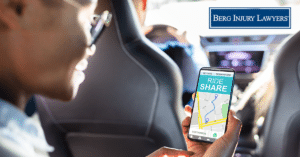 Rideshare services have become perhaps the most common way to hail a ride. As of 2019, more than one-third of American adults had used a rideshare service like Lyft or Uber, more than double the percentage from 2015.
Judging by those numbers, rideshare services seem like they’re here to stay. That means we’ll inevitably see an increase in the number of crashes involving vehicles bearing the Lyft or Uber logo—and the person in the other vehicle could be you or someone you love.
This brings us to our topic of discussion: How can you sue a rideshare company after being involved in an accident?
Rideshare services have become perhaps the most common way to hail a ride. As of 2019, more than one-third of American adults had used a rideshare service like Lyft or Uber, more than double the percentage from 2015.
Judging by those numbers, rideshare services seem like they’re here to stay. That means we’ll inevitably see an increase in the number of crashes involving vehicles bearing the Lyft or Uber logo—and the person in the other vehicle could be you or someone you love.
This brings us to our topic of discussion: How can you sue a rideshare company after being involved in an accident?
The Complexity of Suing a Rideshare Company
This biggest issue when filing a rideshare accident lawsuit is whether you’re suing the driver of the vehicle or the company that backs them. Lyft and Uber drivers are considered contractors, which means they aren’t technically employees of the rideshare service they drive for. There are several reasons rideshare companies don’t “hire” drivers, one of which is the issue of liability. By working with contractors instead of employees, companies like Lyft and Uber insulate themselves from accountability if their driver is involved in a crash—at least partially.Who Exactly Are You Suing?
To determine who you should take legal action against, you’ll need to pay close attention to the details of your situation. If a rideshare driver isn’t actively working (meaning they’re off the clock) when the accident happens, you will likely file a lawsuit against the driver. If a driver is working but has no passenger, you have more options available. The rideshare company might have an insurance policy that covers these situations, though the policy will likely pay out less than if the driver was actively transporting a passenger. In these cases, you could have the option of suing the driver or the company. Once a rideshare driver has a passenger in the vehicle, the company that they have a contract with can be sued for the compensation you’re owed. This is true whether you’re the passenger in the rideshare vehicle or the driver of a vehicle involved in a collision with the rideshare vehicle. Ultimately, these claims can quickly become more complex than the average vehicle accident case. You’re not only dealing with a driver, but the company they’re contracting for and either or both parties’ insurers. We can tell you from experience that insurance companies aren’t quick to offer fair settlements. In many cases, they’ll offer a lowball settlement to eliminate the possibility of any claims. It’s important that you speak to an attorney to make sure you aren’t being taken advantage of.How to File a Lawsuit Against a Rideshare Service
To take legal action against a rideshare service, you’ll need to go through the traditional process of filing a lawsuit. This includes filing a complaint, serving the complaint to the defendant (the person you’re alleging fault against), waiting for their response, gathering evidence and building a case in the discovery phase, and settling the claim or going to trial, depending on the willingness of the defendant to comply with your demands. This a very simplistic summary of what is asked of someone filing a personal injury claim. Each of these steps can quickly become more complicated if the defendant pushes back. Keep in mind that if you choose to go it alone in a lawsuit against a big company like Lyft or Uber, you’ll be up against a well-funded opponent who handles these types of cases regularly. As attorneys who have handled many crash-related lawsuits against big companies, we strongly suggest you speak to an attorney as soon as possible after your crash. Avoid speaking to the representatives of any insurance company that isn’t your own. The sooner you have an advocate on your side to handle the insurance company, the better your chances of a successful outcome.The Future of Rideshare Lawsuits
In May 2020, California Attorney General Xavier Becerra filed a lawsuit in San Francisco County Superior Court against both Uber and Lyft. The lawsuit alleges that these companies are depriving workers of essential protections by misclassifying them as contractors instead of employees. Depending on how this lawsuit plays out, the ways in which injured people can file claims against rideshare companies could change dramatically. In the meantime, it’s important for injured motorists not to accept initial offers from rideshare companies’ insurers without knowing what their claims are truly worth.If You Need an Attorney Who Will Fight for You, Contact Us
At Berg Injury Lawyers, we’ve been standing up for injured motorists for nearly four decades. We deal firmly with insurance companies to make sure our clients get treated fairly. If you want to discuss the details of your case to find out your best path to compensation, schedule a free consultation with our Northern California auto accident attorneys. Worried about our fees and whether you can afford them? Don’t be. We don’t get paid unless we win you money. Contact our team today for a free case assessment.What Should You Do if You Witness an Accident?
| June 1st, 2020
 Crashes are an everyday occurrence in California. In fact, there were nearly 500,000 auto accidents in California in 2017. That’s an average of more than 1,300 crashes every day. If you’ve never witnessed one, the chances are good you will at some point in your lifetime.
So, if you’re wondering what to do when you witness an accident, you’ve come to the right place. The steps you take in the moments after a crash can make a big difference in people’s lives.
Let’s look at the most important things you should (and shouldn’t) do after witnessing a car accident in California.
Crashes are an everyday occurrence in California. In fact, there were nearly 500,000 auto accidents in California in 2017. That’s an average of more than 1,300 crashes every day. If you’ve never witnessed one, the chances are good you will at some point in your lifetime.
So, if you’re wondering what to do when you witness an accident, you’ve come to the right place. The steps you take in the moments after a crash can make a big difference in people’s lives.
Let’s look at the most important things you should (and shouldn’t) do after witnessing a car accident in California.
What to Do If You Witnessed a Car Accident
As a witness, your first priority is to provide assistance without doing any harm to yourself or those involved in the crash. While your actions can be helpful or even lifesaving, taking the wrong steps may put you and others in danger. Keep the following steps in mind to be an effective and safety-conscious Good Samaritan: Don’t put yourself in harm’s way. Throughout every step listed below, keep your own safety in mind. If a crash happens in heavy traffic, be mindful of oncoming vehicles. If a vehicle has been badly damaged, remember that the vehicle itself is a threat to your safety. Always act with caution. Report a crash to the authorities as soon as possible. Typically, someone involved in the crash will notify the authorities. However, it’s possible they might not be able to do so. For example, if a driver strikes a pedestrian or an idle vehicle and speeds away, a third party’s report might be necessary. That’s why you should always call 911—never assume someone else already has. Give a statement to the police officer responding to the scene. When a police officer responds to the scene, you can give the officer your account of what happened. This information might play an important role in the report the officer files. Once you’re finished speaking to the officer, you can ask them if they need any other information before you leave. Offer your contact information to one of the drivers involved in the crash. When you’ve witnessed a car accident, you can offer your contact information so they, their insurance company, or their lawyer have the option of following up with you later if they need more information. Insurance claims stemming from crashes are often contested by insurance companies, so your account of what you witnessed could be a valuable asset for the driver. Call for medical assistance rather than trying to move an injured person yourself. If someone inside the vehicles involved is badly injured, let emergency medical responders handle them. You might inadvertently worsen injuries by trying to move the person to a safe place. Of course, there are exceptions. California’s Good Samaritan Law protects people from liability when they try to help someone who needs to be rescued. If it’s an absolute emergency, and you’re confident in your ability to help, then you can. In all other circumstances, call emergency responders and wait for help. Take pictures of the scene—if needed. Photographs of a crash can be valuable in the insurance claims process. If drivers are incapacitated, you might be able to help them by taking pictures of the crash’s aftermath. However, if at all possible, consider asking one of the drivers for permission first. Look for other ways to help injured people. You might be able to help an injured person by contacting their loved ones, supplying first aid items, or doing something as simple as offering them water, a blanket, or a pen and paper to write down important information. The best way to find out how to help those involved in a crash is by simply asking. There are also several things you don’t want to do when you witness a car accident. Tensions sometimes run high after a crash, so you don’t want to introduce any additional hostility. When you lend your hand to those involved, try your best to be a calming presence. In summary, there are several ways to help crash victims without putting yourself or others in harm’s way. Be cautious, contact the authorities, and look for unobtrusive ways to make people’s lives easier. Consider the help you’d need if you were involved in a crash and act accordingly.If You Need Help After a Crash, Contact Berg Injury Lawyers
At Berg Injury Lawyers, we have years of experience helping people after a serious vehicle accident. We know how important the minutes, days, and weeks after a crash can be, especially when it comes to the insurance claims process. We help our clients get the service and legal representation they need to get their lives back in order after a wreck. If you or someone you care about was involved in a crash, you can call our firm anytime to schedule a free consultation.What are California’s Crosswalk Laws?
| May 25th, 2020
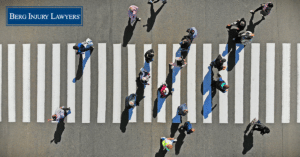 California’s road laws aren’t just for motorists. Pedestrians have clear rights and laws they must follow, too.
It’s important for both drivers and pedestrians to understand the laws (and best practices) for navigating intersections, which is why we’re giving pedestrians the lowdown on California’s crosswalk laws.
California’s road laws aren’t just for motorists. Pedestrians have clear rights and laws they must follow, too.
It’s important for both drivers and pedestrians to understand the laws (and best practices) for navigating intersections, which is why we’re giving pedestrians the lowdown on California’s crosswalk laws.
So, What Are California’s Crosswalk Laws?
CVC §21950 says that drivers should yield the right-of-way to a pedestrian crossing the roadway within any marked crosswalk or within any unmarked crosswalk at an intersection. However, there are a couple of important caveats. California’s law does not absolve a pedestrian from the duty of “using care” for their safety. The statute says that “no pedestrian may suddenly leave a curb or other place of safety and walk or run into the path of a vehicle that is so close as to constitute an immediate hazard. No pedestrian may unnecessarily stop or delay traffic while in a marked or unmarked crosswalk.” The remainder of the statutes in this law pertain specifically to the responsibilities of drivers. It states that drivers approaching a pedestrian within “any marked or unmarked crosswalk shall exercise all due care and shall reduce the speed of the vehicle or take any other action” required to keep pedestrians safe.What Does That Mean for Pedestrians?
California’s pedestrian law is somewhat at odds with commonly held wisdom that pedestrians always have the right-of-way, but it doesn’t absolve drivers from their share of responsibilities, either. It’s true that pedestrians using crosswalks have the right-of-way, but from both a legal and safety standpoint, it’s important not to stop in the middle of that crosswalk, if at all possible. Some of the other language used in the statute is also open to interpretation. For example, the laws states that pedestrians shouldn’t “suddenly leave a curb into the path of a vehicle” in a way that presents an “immediate hazard.” Terms like “suddenly” and “immediate hazard” introduce ambiguity into an otherwise clear-cut law. As you can imagine, this ambiguity is a focus for attorneys who are representing clients in cases involving pedestrian collisions on both sides of the issue.The Legal Implications of a Pedestrian Collision
If a pedestrian is injured by a driver and files a legal claim, it’s possible the driver’s attorney will argue that the pedestrian walked into the street without warning, even if the pedestrian believes it would be obvious to any responsible driver that they were crossing the street. This highlights the need for an experienced attorney when a legal dispute emerges from a pedestrian collision. An injured pedestrian will likely need an advocate to make their case using all available facts. An injured pedestrian’s attorney might look for several types of evidence to back up their client’s argument. For example, security or street cameras might have captured footage of the accident, which can be used to reinforce the pedestrian’s claim. An attorney could also ask any eyewitnesses for their account of the collision.What Can Pedestrians Do to Stay Safe?
Pedestrians can keep these safety tips in mind when walking near or across roads:- Whenever possible, use sidewalks and designated crossings.
- Whether or not you’re using a designated crossing, be mindful of oncoming traffic and, when possible, try to make eye contact with drivers to ensure they see you.
- If walking at night, wear brightly colored or reflective clothing.
- If no sidewalk is available, walk facing traffic while maintaining a safe distance from the road.
What Are Driver’s Responsibilities Near Pedestrians?
Drivers must follow all the rules of the road to keep pedestrians safe. They can further protect pedestrians by following these guidelines:- Always give pedestrians the right-of-way.
- Slow down when near crosswalks or in areas where pedestrian traffic volume is high.
- Never pass a vehicle when it is stopped at an intersection or crosswalk.
- Never come to a stop in a crosswalk.
- If a pedestrian makes eye contact with you, assume they’re crossing the street.
- Give vulnerable pedestrians (elderly or disabled people) more time to cross the street.


